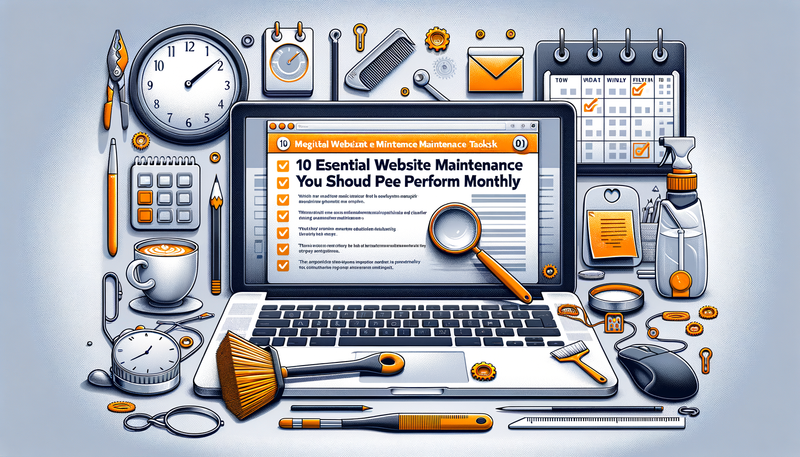10 Essential Website Maintenance Tasks You Should Perform Monthly
Maintaining a website is crucial for its longevity, security, and performance. As a website owner, it's essential to perform regular maintenance tasks to ensure your site remains functional, secure, and up-to-date. This article explores ten vital maintenance tasks that should be carried out on a monthly basis. From security updates to content refreshes and performance optimizations, these tasks will help keep your website running smoothly and effectively. By implementing these practices, you'll enhance user experience, improve search engine rankings, and protect your site from potential threats. Whether you're a small business owner or a large enterprise, these maintenance tasks are applicable to all types of websites and will contribute to your online success.Table of Contents:
-
1. Update Your Content Management System (CMS)
- 2. Review and Update Plugins and Themes
- 3. Perform Security Scans
- 4. Backup Your Website
- 5. Check and Optimize Website Speed
- 6. Review and Update Content
- 7. Check and Fix Broken Links
- 8. Monitor and Analyze Website Traffic
- 9. Test and Optimize Forms and Call-to-Actions (CTAs)
- 10. Review and Update User Permissions
- 2. Review and Update Plugins and Themes
- 3. Perform Security Scans
- 4. Backup Your Website
- 5. Check and Optimize Website Speed
- 6. Review and Update Content
- 7. Check and Fix Broken Links
- 8. Monitor and Analyze Website Traffic
- 9. Test and Optimize Forms and Call-to-Actions (CTAs)
- 10. Review and Update User Permissions

1. Update Your Content Management System (CMS)
Keeping your CMS up-to-date is crucial for maintaining your website's security and functionality. Most CMS platforms release regular updates that address security vulnerabilities, bug fixes, and new features. Set aside time each month to check for and install any available updates for your CMS.This task is particularly important for popular CMS platforms, as they are often targeted by hackers. By staying current with updates, you'll ensure that your website is protected against the latest security threats and benefits from the newest features and improvements.
Do you need a website? Want to build a website but don't know where to start? Our website builder is the perfect solution. Easy to use, and with the ability to customize to fit your business needs, you can have a professional website in no time.
2. Review and Update Plugins and Themes
Similar to your CMS, plugins and themes also require regular updates. Outdated plugins and themes can create security vulnerabilities and compatibility issues. Make it a monthly habit to review all installed plugins and themes, checking for available updates.When updating, it's advisable to create a backup of your site first, as some updates may cause conflicts. After updating, thoroughly test your website to ensure everything is functioning correctly. If you encounter any issues, you can revert to the backup and address the problem before proceeding with the update.
3. Perform Security Scans
Regular security scans are essential to detect and prevent potential threats to your website. Use reputable security plugins or services to scan your website for malware, viruses, and other security vulnerabilities. Many security tools offer automated scans, but it's important to review the results monthly and take necessary actions.If any issues are detected, address them immediately. This may involve removing malicious code, updating compromised passwords, or seeking assistance from a security professional. By conducting regular scans, you can catch and resolve security issues before they escalate into major problems.
Building a website with SITE123 is easy
4. Backup Your Website
Creating regular backups of your website is crucial for disaster recovery and peace of mind. While many hosting providers offer automatic backups, it's wise to perform your own backups as an additional precaution. Set up a monthly backup schedule to ensure you always have a recent copy of your website's files and database.Store your backups in a secure, off-site location, such as cloud storage or an external hard drive. This practice will protect your data from server failures, hacking attempts, or accidental deletions. In the event of a website crash or data loss, you'll be able to quickly restore your site to its previous state.
5. Check and Optimize Website Speed
Website speed is a critical factor for user experience and search engine rankings. Use tools like Google PageSpeed Insights or GTmetrix to analyze your website's loading times and receive optimization suggestions. Dedicate time each month to review these reports and implement recommended improvements.Common speed optimization tasks include compressing images, minifying CSS and JavaScript files, leveraging browser caching, and optimizing database queries. By consistently working on your website's speed, you'll provide a better user experience and potentially improve your search engine rankings.
6. Review and Update Content
Fresh, relevant content is essential for engaging visitors and improving search engine visibility. Set aside time each month to review your website's content, updating outdated information and adding new, valuable content. This could involve updating product descriptions, refreshing blog posts, or adding new pages to reflect changes in your business or industry.Pay special attention to your most important pages, such as your homepage and key landing pages. Ensure that all information is accurate and up-to-date. Regular content updates not only keep your website relevant but also signal to search engines that your site is active and maintained.
7. Check and Fix Broken Links
Broken links can negatively impact user experience and search engine rankings. Use tools like Google Search Console or dedicated link checker tools to identify broken links on your website. Once identified, fix these links by updating them to the correct URLs or removing them if the content is no longer available.Don't forget to check both internal and external links. For external links that are consistently broken, consider finding alternative resources or removing them altogether. Regularly fixing broken links ensures a smooth browsing experience for your visitors and maintains the integrity of your website's link structure.
8. Monitor and Analyze Website Traffic
Regularly monitoring your website's traffic provides valuable insights into user behavior and helps identify areas for improvement. Use analytics tools like Google Analytics to review key metrics such as visitor numbers, popular pages, bounce rates, and conversion rates.Look for trends in your data and use this information to guide your content strategy and website improvements. For example, if you notice a high bounce rate on certain pages, investigate why users are leaving quickly and make necessary adjustments. By staying informed about your website's performance, you can make data-driven decisions to improve user engagement and achieve your online goals.
9. Test and Optimize Forms and Call-to-Actions (CTAs)
Forms and CTAs are crucial elements for converting visitors into leads or customers. Regularly test all forms on your website to ensure they're functioning correctly and submitting data as intended. Check that confirmation emails or thank-you pages are working properly.Additionally, review your CTAs to ensure they're clear, compelling, and strategically placed. A/B test different variations of your CTAs to identify which ones perform best. By optimizing these elements, you can improve your website's conversion rates and overall effectiveness in achieving your business objectives.
10. Review and Update User Permissions
If your website has multiple users or contributors, it's important to regularly review and update user permissions. This helps maintain security and ensures that users only have access to the areas and functions they need. Check for any inactive accounts and remove or disable them to reduce potential security risks.For active users, verify that their permission levels are appropriate for their current roles. If there have been changes in responsibilities, adjust permissions accordingly. This practice helps prevent unauthorized access and maintains the integrity of your website's content and functionality.





